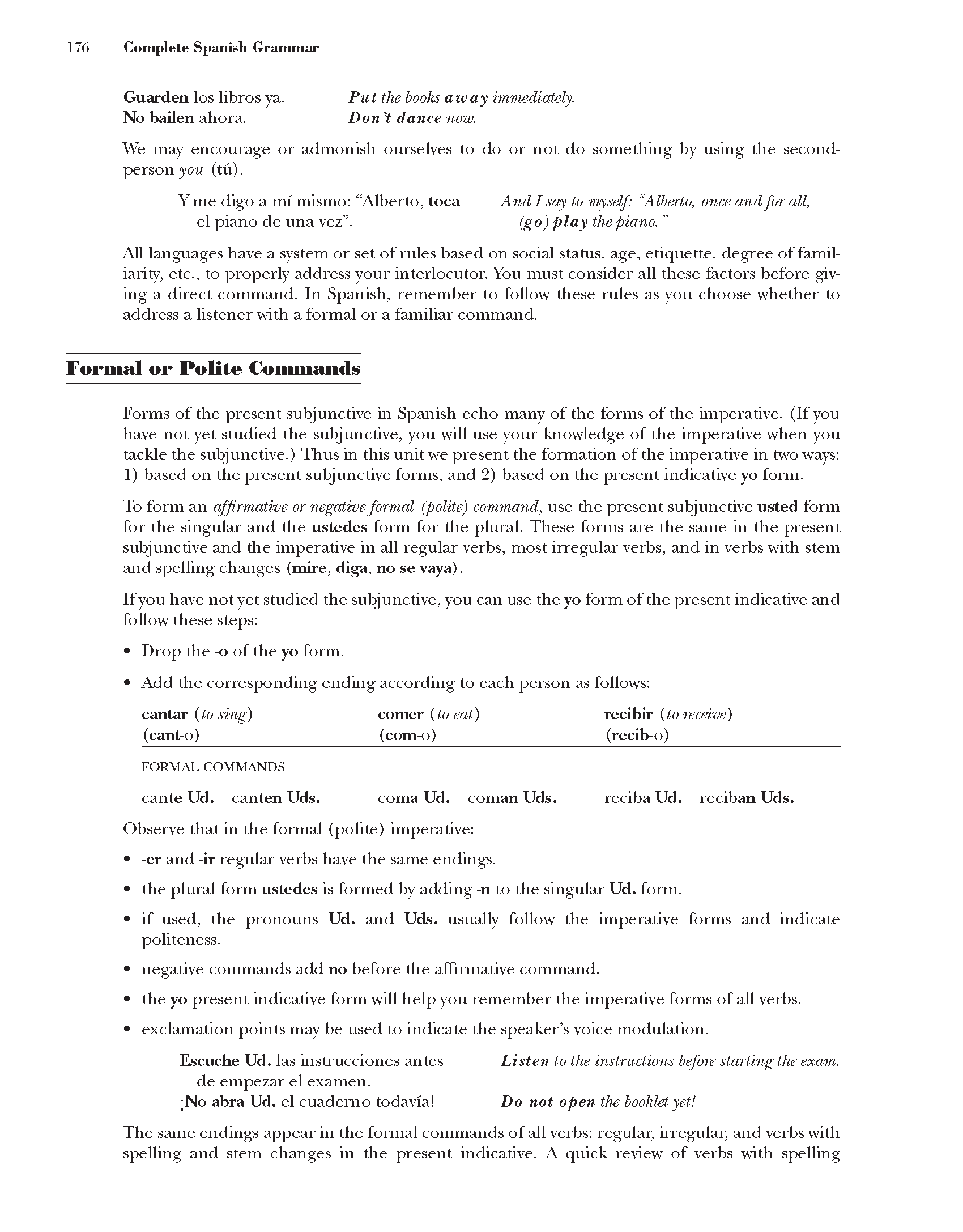CSG187

176 Complete Spanish Grammar
Guarden los libros ya. Pu t the books away immediately.
No bailen ahora. Don ’t dance now.
We may encourage or admonish ourselves to do or not do something by using the second-person you (tu).
Y me digo a mi mismo: “Alberto, toca And I say to myself: “Alberto, once and for all,
el piano de una vez”. (go) play the piano. ”
All languages have a system or set of rules based on social status, age, etiquette, degree of famil-iarity, etc., to properly address your interlocutor. You must consider all these factors before giv-ing a direct command. In Spanish, remember to follow these rules as you choose whether to address a listener with a formal or a familiar command.
Formal or Po litr Coiiimamls
Forms of the present subjunctive in Spanish echo many of the forms of the imperative. (If you have not yet studied the subjunctive, you will use your knowledge of the imperative when you tackle the subjunctive.) Thus in this unit we present the formation of the imperative in twoways: 1) based on the present subjunctive forms, and 2) based on the present indicative yo form.
To form an affirmative or negatwe formal (polite) command, use the present subjunctive usted form for the singular and the ustedes form for the plural. These forms are the same in the present subjunctive and the imperative in all regular verbs, most irregular verbs, and in verbs with stem and spelling changes (mirę, diga, no se vaya).
Ifyou have not yet studied the subjunctive, you can use the yo form of the present indicative and follow these steps:
• Drop the -o of the yo form.
• Add the corresponding ending according to each person as follows:
cantar (to sing) comer (to eat) recibir (torecewe)
(cant-o) (com-o) (recib-o)
FORMAL COMMANDS
cante Ud. canten Uds. coma Ud. comaii Uds. reciba Ud. reciban Uds.
Observe that in the formal (polite) imperative:
• -er and -ir regular verbs have the same endings.
• the plural form ustedes is formed by adding -n to the singular Ud. form.
• if used, the pronouns Ud. and Uds. usually follow the imperative forms and indicate politeness.
• negative commands add no before the affirmative command.
• the yo present indicative form will help you remember the imperative forms of all verbs.
• exclamation points may be used to indicate the speaker’s voice modulation.
Escuche Ud. las instrucciones antes Li sten to the instructions before starting the exam.
de empezar el examen.
jNo abra Ud. el cuaderno todavia! Do not open the booklet yet!
The same endings appear in the formal commands of all verbs: regular, irregular, and verbs with spelling and stem changes in the present indicative. A quick review of verbs with spelling
Wyszukiwarka
Podobne podstrony:
CSG187 176 Complete Spanish Grammar Guarden los libros ya. Pu t the books away imm
CSG193 182 Complete Spanish Grammar Compra los lapices. Buy thepencils. jAprende l
CSG243 232 Complete Spanish Grammar 5. ^Compraste los refrescos? No, 6.
CSG249 238 Complete Spanish Grammar ejercicio Los infinitivos: las posibilidades. Sustituye el objęt
CSG099 88 Complete Spanish GrammarThe Coiiiniands in Reflexlve Construetions In the previous example
CSG025 14 Complete Spanish Grammar My son Rob comes into the kitchen and listens to my instructions.
CSG065 54 Complete Spanish Grammar Gertain expressions of time stress the customary or repetitive na
więcej podobnych podstron